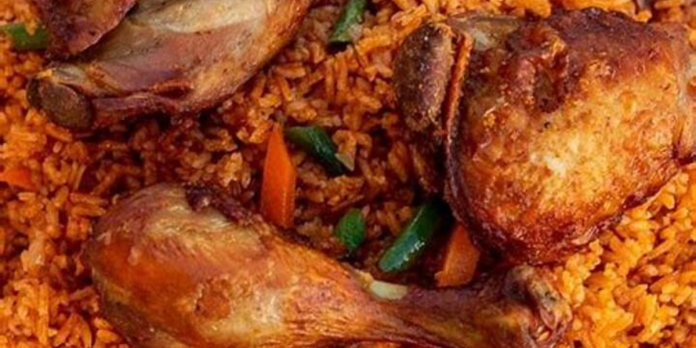Table of Contents
When thinking of the most iconic Nigerian dinner ideas, several dishes come to mind that have become staples in homes across Nigeria and among the Nigerian diaspora worldwide. Nigerian cuisine is incredibly diverse and bursting with flavor, thanks to the use of indigenous spices, ingredients, and cooking techniques. This article delves into the five most popular Nigerian dinner options: Fried Rice, Jollof Rice, Amala and Ewedu, Eba and Egusi, and Ewa Agoyin. Whether you’re new to Nigerian food or looking for a deeper understanding of these popular meals, this guide provides everything you need to know, from ingredients and preparation to cultural significance.
1. Fried Rice: A Party Favorite and Weeknight Staple( Nigerian dinner ideas)
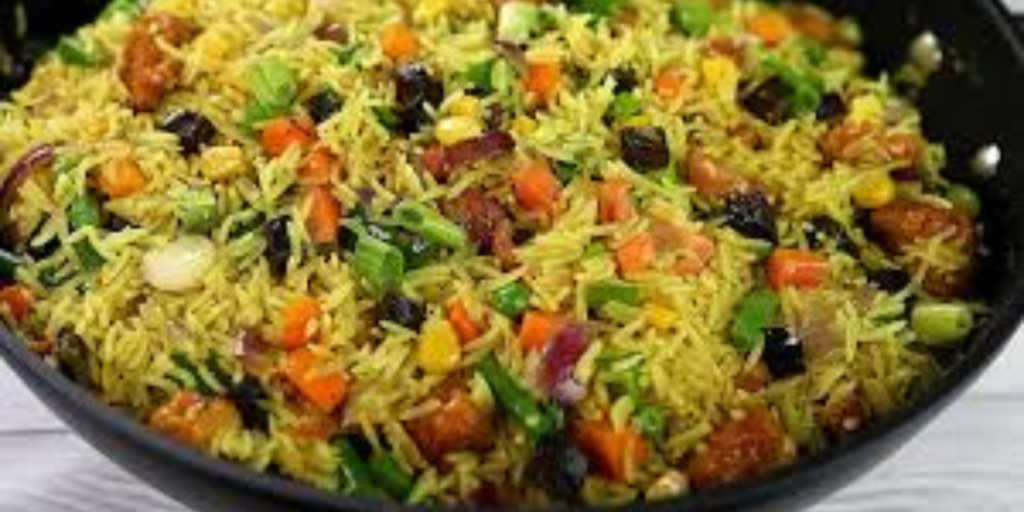
Fried rice is a popular dish not only in Nigeria but also around the world. However, Nigerian Fried Rice has a unique twist that sets it apart from other versions you might find in places like Asia or the Caribbean. This dish is a colorful medley of vegetables, meats, and seasonings that come together to create an exciting and flavorful meal. Fried rice is often reserved for special occasions in Nigeria, but it’s also enjoyed as a regular dinner choice, making it a versatile addition to any dinner table. Nigerian dinner ideas
The Origins of Nigerian Fried Rice(Nigerian dinner ideas)
Fried rice, as a concept, is believed to have originated in China during the Sui Dynasty (circa 589–618 AD) as a way to repurpose leftover rice. From there, fried rice traveled across different cultures, each adapting it to suit their own tastes. In Nigeria, fried rice evolved with the introduction of new ingredients like curry powder, thyme, and bouillon cubes, giving it the rich flavor we recognize today. Nigerian Fried Rice is a beloved party dish, served at celebrations such as weddings, birthdays, and festive gatherings, though it’s equally suitable for casual meals.
Ingredients for Nigerian Fried Rice
The beauty of Nigerian fried rice lies in the balance between simplicity and flavor. Here’s what you’ll need to prepare this dish:
- Parboiled long-grain rice: Long-grain rice works best for Nigerian fried rice as it absorbs the flavors well and doesn’t become too mushy.
- Mixed vegetables: A typical Nigerian fried rice includes diced carrots, green peas, sweet corn, and green beans, but other vegetables can be added based on preference.
- Bell peppers and onions: These add a lovely crunch and aroma to the dish.
- Proteins: Fried or grilled chicken, beef, shrimp, or liver. Liver is especially popular in Nigerian fried rice.
- Seasoning cubes (Maggi or Knorr): These provide a deep umami flavor to the rice.
- Curry powder and thyme: These are essential to achieve the signature yellow color and slightly earthy taste that distinguishes Nigerian fried rice.
- Vegetable oil or butter: For frying the rice and vegetables.
- Garlic and ginger (optional): To add a little extra kick.
- Salt and pepper to taste.
How to Prepare Nigerian Fried Rice
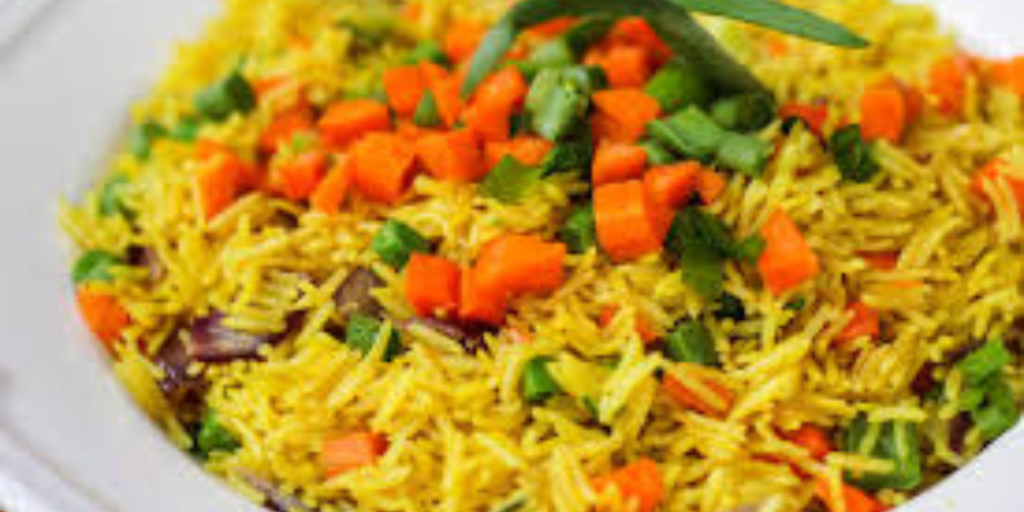
Step 1: Parboiling the Rice
The first step in making perfect Nigerian fried rice is to parboil the rice. This means partially cooking the rice so that it’s about 70% done. Wash the long-grain rice thoroughly to remove excess starch, then bring a pot of water to a boil and add the rice. Cook for about 10 minutes, then drain and set aside.
Step 2: Frying the Vegetables
In a large skillet or wok, heat vegetable oil or butter over medium heat. Add chopped onions and bell peppers, sautéing them until soft and fragrant. Then, toss in the mixed vegetables—carrots, peas, and green beans—and cook for a few minutes until they are tender but still have a slight crunch.
Step 3: Cooking the Rice
Add curry powder and thyme to the vegetables, along with your seasoning cubes. Stir well to combine, ensuring that the vegetables are well-coated with the seasonings. Now, slowly add the parboiled rice to the pan, mixing thoroughly to make sure the rice is evenly coated with the vegetable and seasoning mixture. If using proteins like liver, shrimp, or beef, you can stir them in at this point. Reduce the heat to low and let the rice cook slowly, stirring occasionally to avoid sticking. You may add a bit of chicken or beef stock to enhance the flavor.
Step 4: Final Touches
Taste the rice and adjust the seasoning if necessary. Once everything is well combined, let the rice cook for another 5-10 minutes on low heat. The rice should be fluffy, with a vibrant yellow color and aromatic smell from the curry powder and thyme. You can garnish with freshly chopped green onions for an extra pop of color and flavor.
Variations of Nigerian Fried Rice (Nigerian dinner ideas)
- Liver Fried Rice: This variation involves adding fried or grilled liver to the dish for a unique texture and flavor. The liver is often fried separately and stirred into the rice during the final stages of cooking.
- Shrimp Fried Rice: This is another popular variation that adds shrimp to the dish, giving it a seafood twist.
- Vegetarian Fried Rice: Simply omit the meat or seafood and add more vegetables for a colorful and healthy alternative.
The Cultural Significance of Fried Rice in Nigeria (Nigerian dinner ideas)
Fried rice is one of the most popular party dishes in Nigeria, and it is often served alongside other staples like Jollof rice and moi moi (steamed bean pudding). Its versatility means it can be paired with many other Nigerian dishes, from fried plantains to grilled chicken. While fried rice is a regular feature at parties and large gatherings, it’s also commonly made for weeknight dinners due to its ease of preparation and the ability to customize it with various ingredients.
Nutritional Value of Fried Rice
Nigerian fried rice is packed with nutrients thanks to the variety of vegetables and proteins used in its preparation. The rice itself provides carbohydrates for energy, while the vegetables offer a rich source of vitamins and minerals. If you include shrimp or liver, you’ll get a good dose of protein and iron, making this dish not only delicious but also nutritious.
Health Benefits of Zobo Drink Without Sugar Best of 2024
2. Jollof Rice: The Heart of Nigerian Cuisine ( Nigerian dinner ideas)

Perhaps no dish is as iconic in Nigerian cuisine as Jollof Rice. Jollof rice is a staple meal, and its reputation extends far beyond the borders of Nigeria. The rich tomato-based dish is a point of pride across West Africa, with each country having its own version of Jollof. However, Nigerian Jollof is widely considered one of the best. In fact, it’s not uncommon for lively debates to occur over which country or even which region within Nigeria makes the best Jollof rice.
The Origins of Jollof Rice (Nigerian dinner ideas)
The origins of Jollof rice can be traced back to the Wolof Empire, a historical empire that existed between the 14th and 16th centuries in the region now known as Senegal and parts of The Gambia. The dish was originally made with millet, but as rice became more widely available, it replaced millet as the grain of choice. Over time, Jollof rice spread to other parts of West Africa, including Nigeria, where it became an indispensable part of the culinary landscape.
Ingredients for Nigerian Jollof Rice (Nigerian dinner ideas)
The hallmark of Nigerian Jollof rice is its bright red color, which comes from the tomato-based sauce that the rice is cooked in. Here’s what you’ll need to make this dish:
- Parboiled long-grain rice: As with fried rice, long-grain rice is ideal for Jollof as it absorbs the sauce without becoming mushy.
- Tomatoes and tomato paste: The base of the sauce that gives Jollof its signature flavor.
- Bell peppers and onions: These enhance the flavor and add a slight sweetness to the sauce.
- Scotch bonnet peppers: For heat. Nigerian Jollof rice is known for having a bit of a kick.
- Garlic and ginger: These aromatic ingredients deepen the flavor of the dish.
- Thyme and bay leaves: These herbs add complexity to the tomato sauce.
- Chicken or beef stock: Adds richness to the dish and ensures the rice is moist and flavorful.
- Seasoning cubes: Maggi or Knorr cubes are a common seasoning for Jollof rice.
- Vegetable oil: For frying the tomato paste and peppers.
- Proteins: Fried or grilled chicken, beef, or fish often accompanies Jollof rice.
- Salt and pepper to taste.
How to Prepare Nigerian Jollof Rice (Nigerian dinner ideas)
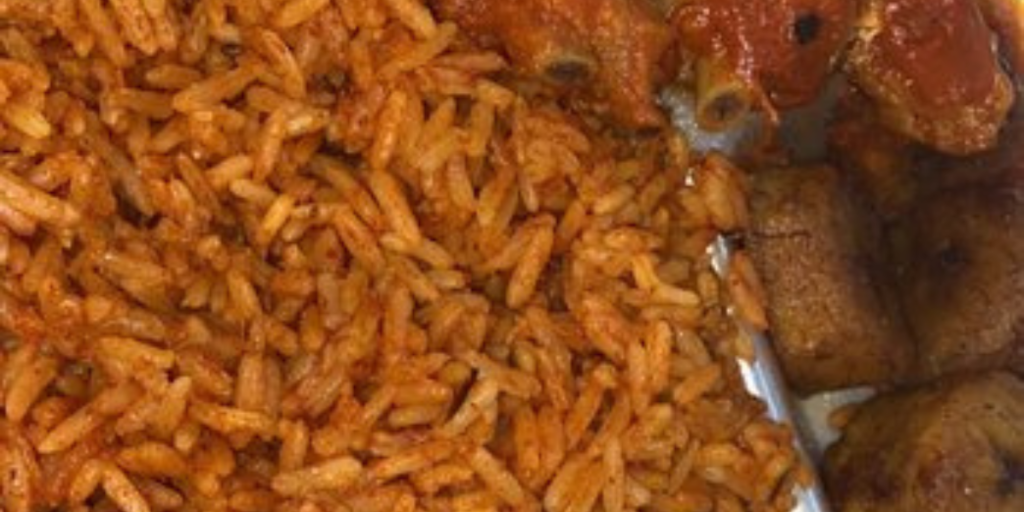
Step 1: Prepare the Tomato Sauce
Begin by blending fresh tomatoes, bell peppers, onions, and scotch bonnet peppers into a smooth paste. Heat vegetable oil in a large pot and add the tomato paste, frying it until it thickens and the oil begins to separate from the sauce. This process can take about 10-15 minutes. Once the tomato paste is ready, add your blended tomato mixture and cook for another 10-15 minutes until the sauce reduces and the flavors intensify.
Step 2: Season the Sauce
Once your sauce has thickened, add thyme, bay leaves, and seasoning cubes. Stir everything together, then pour in chicken or beef stock. This liquid will be absorbed by the rice, adding depth to the dish’s flavor. Taste the sauce and adjust the seasoning with salt and pepper.
Step 3: Cook the Rice
Now it’s time to add the parboiled long-grain rice to the pot. Stir the rice into the sauce, making sure it’s well-coated. Reduce the heat to low, cover the pot with a tight-fitting lid, and let the rice cook for 20-30 minutes, stirring occasionally to prevent burning. If the rice is too dry, you can add more stock or water, but be careful not to add too much, as the rice should not be soggy.
Step 4: Final Adjustments
Once the rice is fully cooked and the sauce has been absorbed, your Jollof rice should be bright red and bursting with flavor. Remove the bay leaves before serving. You can garnish with sliced onions, bell peppers, or fried plantains for a complete meal.
Variations of Jollof Rice
- Party Jollof: This version of Jollof rice is cooked over an open flame, giving it a smoky flavor that is highly prized at Nigerian gatherings.
- Mixed Jollof: Some people like to add vegetables like peas, carrots, or sweet corn to their Jollof rice for added texture and nutrition.
- Seafood Jollof: For a twist, try adding shrimp, crab, or other seafood to your Jollof rice.
The Cultural Significance of Jollof Rice in Nigeria (Nigerian dinner ideas)
Jollof rice is not just a meal; it’s a cultural experience. The dish is a fixture at Nigerian weddings, parties, and festivals, and it’s often served alongside fried chicken, moi moi, or dodo (fried plantains). For many Nigerians, Jollof rice is a taste of home and a reminder of family gatherings and special occasions. The ongoing “Jollof Wars,” which pit Nigeria’s version against that of Ghana, Sierra Leone, and other West African nations, only underscores the dish’s importance in Nigerian culture.
Nutritional Value of Jollof Rice
Jollof rice is a hearty dish that provides a good balance of carbohydrates, proteins, and fats. The tomato sauce is rich in vitamins A and C, while the rice offers energy-boosting carbs. Depending on the protein you pair it with—beef, chicken, or fish—you’ll also get a healthy dose of protein and other essential nutrients.
How to Make Zobo Drink with Honey Best of 2024
3. Amala and Ewedu: A Traditional Yoruba Delight ( Nigerian dinner ideas)

Amala is a traditional Yoruba dish made from yam flour, cassava flour, or plantain flour, while Ewedu is a jute leaf soup that is often served with Amala. This combination is a deeply satisfying meal that has been enjoyed for generations in the southwestern part of Nigeria, particularly among the Yoruba people. Amala is known for its distinct dark color and smooth texture, while Ewedu provides a slimy, earthy flavor that complements the starchy Amala perfectly.
The Origins of Amala and Ewedu
Amala is made from yam, which is a staple food crop in many parts of West Africa. The yams are peeled, dried, and then ground into a fine powder, which is then rehydrated to make Amala. Ewedu, on the other hand, is made from the leaves of the jute plant, a green leafy vegetable that has been cultivated for centuries for both its leaves and its fibrous stems, which are used in making burlap. The combination of Amala and Ewedu has been a part of Yoruba cuisine for centuries, and it continues to be a popular dinner option to this day.
Ingredients for Amala and Ewedu (Nigerian dinner ideas)
To prepare Amala and Ewedu, you’ll need the following ingredients:
- Yam flour (elubo): This is the main ingredient for making Amala. You can also use plantain or cassava flour for variations.
- Jute leaves (ewedu): Fresh or frozen jute leaves are essential for making Ewedu soup.
- Locust beans (iru): A fermented seasoning that adds umami to the Ewedu soup.
- Potash (kaun): This is used to help the Ewedu leaves break down and become slimy.
- Ground crayfish: Adds a savory depth to the Ewedu soup.
- Palm oil: A little palm oil is sometimes added to Ewedu for extra richness.
- Seasoning cubes: Maggi or Knorr cubes are commonly used.
- Salt and pepper to taste.
How to Prepare Amala and Ewedu (Nigerian dinner ideas)
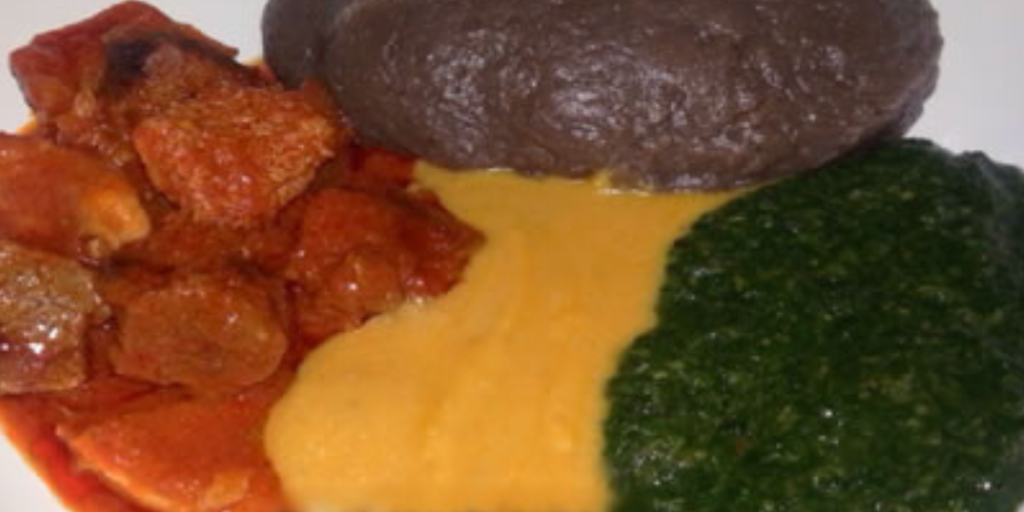
Step 1: Making Amala
To make Amala, bring a pot of water to a boil, then gradually add the yam flour while stirring continuously with a wooden spatula. Keep stirring until the mixture thickens into a smooth, dough-like consistency. If the Amala is too thick, you can add more water and stir until it reaches your desired consistency. Once it’s smooth and free of lumps, remove from heat and set aside.
Step 2: Preparing Ewedu Soup
To make the Ewedu soup, start by washing the jute leaves thoroughly. If you’re using fresh leaves, you’ll need to blend them into a smooth paste using a blender or traditional grinding stone. In a small pot, bring water to a boil and add a pinch of potash. This will help the leaves break down and become slimy. Add the blended jute leaves, locust beans, ground crayfish, and seasoning cubes to the pot, and cook for about 5-10 minutes, stirring frequently. You can add a little palm oil if you like, though this is optional.
Step 3: Serving Amala and Ewedu
Amala is typically served in a large mound alongside the Ewedu soup, which is often accompanied by a side of Gbegiri (bean soup) and a protein such as beef, goat meat, or tripe. The Amala is dipped into the Ewedu and eaten by hand, making for a rich and satisfying meal.
Variations of Amala and Ewedu (Nigerian dinner ideas)
- Amala Isu: Made from yam flour, this is the most common type of Amala.
- Amala Lafun: Made from cassava flour, this variation has a lighter color and slightly different texture.
- Amala Ogede: Made from plantain flour, this is a sweeter and more nutritious version of Amala.
The Cultural Significance of Amala and Ewedu in Nigeria
Amala and Ewedu is a dish that is deeply ingrained in Yoruba culture. It is often served at traditional weddings, naming ceremonies, and other important celebrations. In fact, Amala joints (local restaurants that specialize in Amala and other Yoruba dishes) are popular across southwestern Nigeria. For many Yoruba people, Amala is more than just a meal—it’s a connection to their cultural heritage and a source of pride.
Nutritional Value of Amala and Ewedu (Nigerian dinner ideas)
Amala is a good source of carbohydrates, which provide energy, while Ewedu is packed with vitamins and minerals, including calcium, iron, and vitamins A and C. The jute leaves are also rich in dietary fiber, which aids digestion. When paired with a protein like beef or goat meat, this dish provides a well-balanced meal that is both nutritious and filling.
Zobo Drink Calories: Best Zobo Drink Guide of 2024
4. Eba and Egusi Soup: A Classic Combination ( Nigerian dinner ideas)
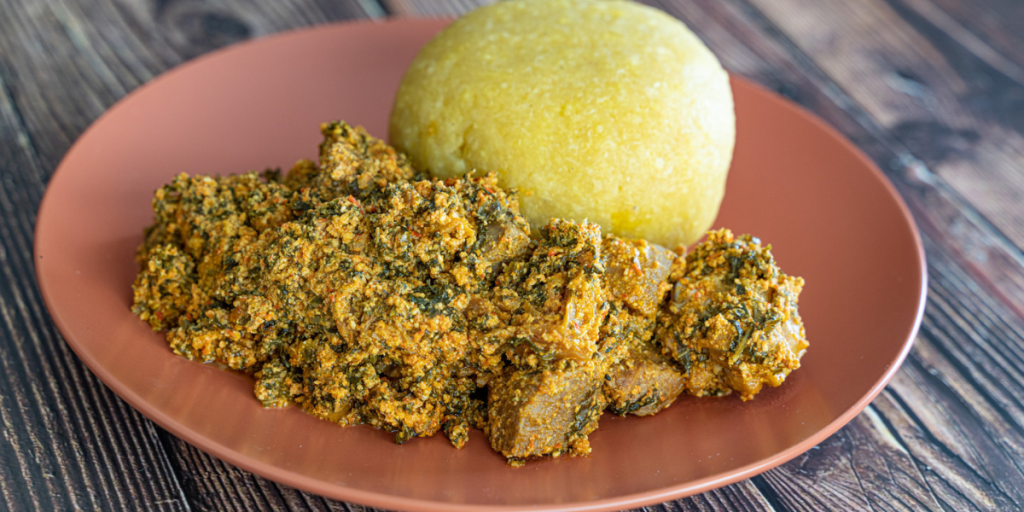
Eba is another popular Nigerian staple made from cassava flour (garri), while Egusi Soup is a thick, hearty soup made from ground melon seeds. This combination is a classic Nigerian dinner option, especially in the southern and eastern parts of the country. Eba is similar to Amala in that it’s a starchy side dish that is typically served with a variety of soups, but Egusi soup is perhaps its most popular pairing.
The Origins of Eba and Egusi Soup (Nigerian dinner ideas)
Eba is made from cassava, a root vegetable that is native to South America but was introduced to Africa during the 16th century. Cassava quickly became a staple food in many parts of Africa due to its versatility and ability to thrive in poor soil conditions. Egusi soup, on the other hand, is made from the seeds of the melon plant, which has been cultivated in West Africa for centuries. The seeds are ground into a fine powder and used to thicken the soup, giving it a rich, nutty flavor.
Ingredients for Eba and Egusi Soup
To prepare Eba and Egusi Soup, you’ll need the following ingredients:
- Cassava flour (garri): This is the main ingredient for making Eba.
- Melon seeds (egusi): These are ground into a fine powder to make the base of the soup.
- Palm oil: Used to fry the egusi and give the soup its distinctive red color.
- Bitterleaf or spinach: These leafy greens are often added to Egusi soup for extra flavor and nutrition.
- Seasoning cubes: Maggi or Knorr cubes are commonly used.
- Ground crayfish: Adds a savory depth to the soup.
- Stockfish or dried fish: These are often added to the soup for extra flavor.
- Beef or goat meat: The protein of choice for Egusi soup.
- Salt and pepper to taste.
How to Prepare Eba and Egusi Soup (Nigerian dinner ideas)
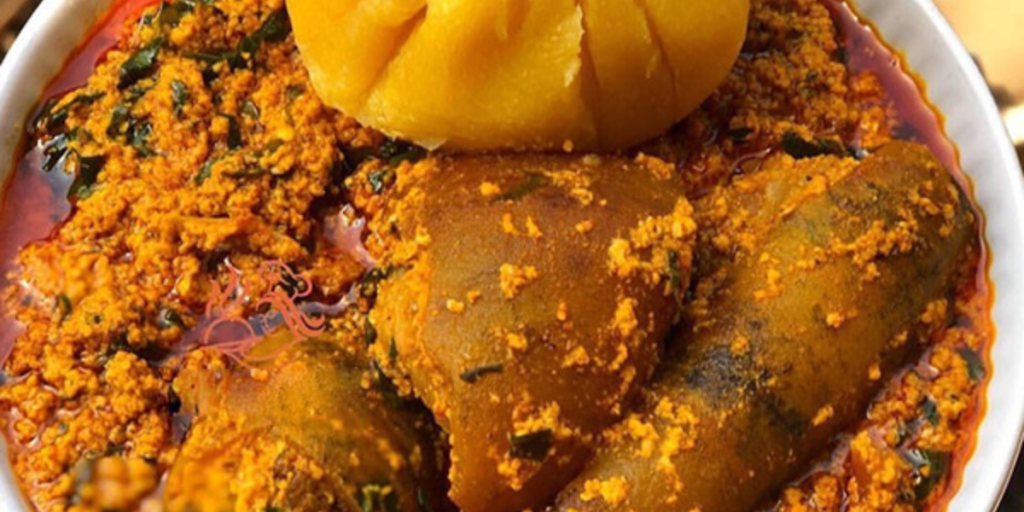
Step 1: Making Eba
To make Eba, bring a pot of water to a boil, then gradually add cassava flour (garri) while stirring continuously with a wooden spatula. Keep stirring until the mixture thickens into a smooth, dough-like consistency. If the Eba is too thick, you can add more water and stir until it reaches your desired consistency. Once it’s smooth and free of lumps, remove from heat and set aside.
Step 2: Preparing Egusi Soup
To make Egusi soup, start by heating palm oil in a pot over medium heat. Add the ground melon seeds (egusi) to the oil and fry for a few minutes, stirring constantly to prevent burning. Next, add your choice of meat (beef, goat, or dried fish) along with seasoning cubes, ground crayfish, and pepper. Cook for 10-15 minutes, stirring occasionally. Then, add water or stock to the pot and let the soup simmer for another 20-30 minutes, until the meat is fully cooked and the egusi has thickened. Add the bitterleaf or spinach towards the end of cooking, and adjust the seasoning to taste.
Step 3: Serving Eba and Egusi Soup
Eba is typically served in a large mound alongside the Egusi soup, which is filled with chunks of meat and leafy greens. The Eba is dipped into the soup and eaten by hand, making for a rich and satisfying meal.
Variations of Egusi Soup
- Lumpy Egusi: Some people prefer their Egusi soup to have lumps of melon seeds, which are formed by frying the egusi in oil before adding water or stock.
- Vegetable Egusi: For a healthier twist, you can add more leafy greens like spinach or kale to your Egusi soup.
- Seafood Egusi: Try adding shrimp, crab, or other seafood to your Eg
The Cultural Significance of Eba and Egusi Soup in Nigeria (Nigerian dinner ideas)
Eba and Egusi Soup are staples in many Nigerian homes, particularly in the southern and eastern regions of the country. The combination is a popular choice for family dinners, celebrations, and festive occasions. The versatility of Egusi Soup, which can be paired with various types of “swallow” (a term for starchy side dishes like Eba, Pounded Yam, or Amala), makes it a beloved meal in Nigerian cuisine. Eba, being easy to prepare and affordable, is a common dinner option for many families.
Egusi Soup, with its rich, hearty texture and nutty flavor, is often seen as a symbol of comfort and home-cooked meals. It’s not uncommon to find large gatherings where multiple bowls of Egusi Soup are served with different types of swallow, each guest having their preferred combination. The soup’s rich history, rooted in West African culture, emphasizes the communal and familial aspects of Nigerian life, as it’s usually shared among family members or at social gatherings.
Nutritional Value of Eba and Egusi Soup
Eba, made from cassava, is rich in carbohydrates, which provide a quick source of energy. Although cassava is low in protein and fat, pairing it with a protein-rich soup like Egusi makes it a balanced meal. Egusi (melon seeds) is a great source of essential fatty acids, protein, and vitamins like vitamin A, B1, and B2. The inclusion of leafy greens like spinach or bitterleaf adds fiber, iron, and additional vitamins, making this a nutritious and filling meal. When served with fish or meat, the meal provides a good balance of macronutrients: carbohydrates, fats, and proteins.
How to Make Zobo Drink Without Sugar Best of 2024
5. Ewa Agoyin: A Flavorful Bean Dish from Lagos ( Nigerian dinner ideas)

Ewa Agoyin is a dish that consists of mashed beans served with a peppery, spicy sauce. Originally from Togo and Benin, this dish has become incredibly popular in southwestern Nigeria, particularly in Lagos. Ewa Agoyin is typically served as a street food, often eaten with bread (agege bread) or fried plantains. Despite its humble origins, Ewa Agoyin has gained widespread appeal for its unique flavor profile and simple, yet satisfying ingredients.
The Origins of Ewa Agoyin
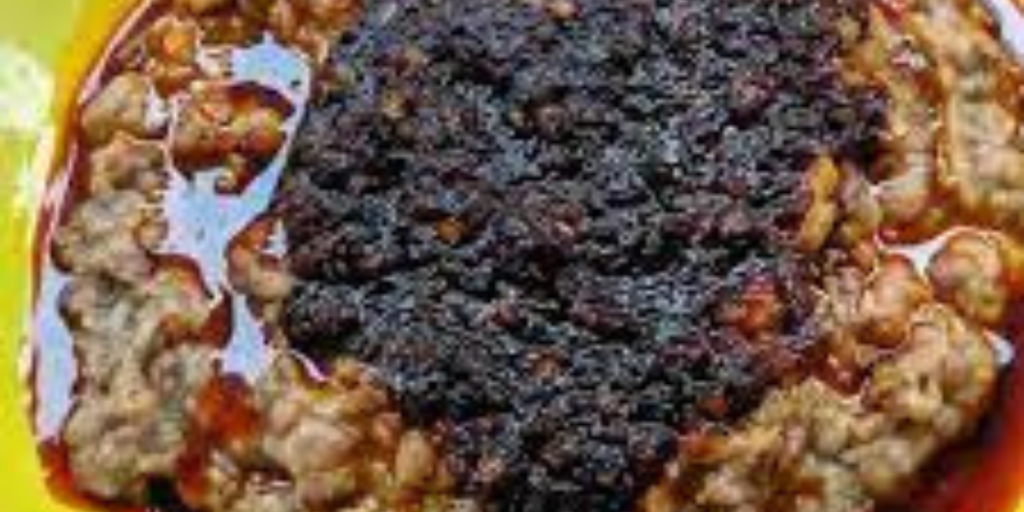
Ewa Agoyin traces its roots to the Agoyin people of Togo and Benin, who migrated to Nigeria during the early 20th century. They brought with them their culinary traditions, and Ewa Agoyin became one of the most beloved dishes they introduced to the Lagos area. The dish’s combination of soft, mashed beans with a spicy, caramelized pepper sauce has made it a go-to dinner option for many Nigerians.
Ingredients for Ewa Agoyin
To make Ewa Agoyin, you’ll need the following ingredients:
- Brown or white beans: The base of the dish, these are cooked until very soft and then mashed.
- Dried chili peppers: These give the sauce its characteristic spicy kick.
- Onions: Caramelized onions add sweetness and depth to the sauce.
- Palm oil: Traditionally used to fry the sauce and infuse it with rich flavor.
- Seasoning cubes: Maggi or Knorr cubes are commonly used.
- Salt to taste.
How to Prepare Ewa Agoyin (Nigerian dinner ideas)
Step 1: Cooking the Beans
Start by soaking the beans overnight to soften them and reduce cooking time. The next day, rinse the beans and cook them in a large pot of water until they are very soft. You want the beans to be so tender that they can be easily mashed with the back of a spoon. Drain any excess water and mash the beans until smooth, then set them aside.
Step 2: Preparing the Agoyin Sauce
To make the Agoyin sauce, start by heating palm oil in a pot over medium heat. Once the oil is hot, add finely chopped onions and fry until they turn golden brown and caramelized. This step is crucial, as the onions need to develop a deep, sweet flavor. Next, add the ground dried chili peppers and stir constantly to prevent burning. The pepper should fry in the oil until it turns a deep red color and releases its spicy aroma. Add seasoning cubes and salt to taste, and cook for an additional 5-10 minutes until the sauce thickens.
Step 3: Serving Ewa Agoyin
Ewa Agoyin is traditionally served by placing a generous portion of mashed beans on a plate and topping it with the spicy Agoyin sauce. It can be enjoyed on its own or served with accompaniments like fried plantains, boiled yams, or bread. In Lagos, it’s common to find street vendors serving Ewa Agoyin with agege bread, a soft, fluffy bread that is perfect for mopping up the sauce.
Variations of Ewa Agoyin
- Ewa Agoyin with Fish: For added protein, some people like to serve their Ewa Agoyin with fried or grilled fish on the side.
- Ewa Agoyin with Plantains: Fried plantains (dodo) are a popular side dish for Ewa Agoyin, adding sweetness that balances out the spicy sauce.
- Ewa Agoyin with Rice: For a more filling meal, Ewa Agoyin can be served with white rice, creating a satisfying contrast between the soft beans and the firm rice grains.
The Cultural Significance of Ewa Agoyin in Nigeria
Ewa Agoyin is more than just a dinner option; it’s a beloved street food that has become part of the cultural fabric of Lagos. Street vendors selling Ewa Agoyin are a common sight in the city, and many Lagosians have fond memories of buying the dish from their favorite roadside stands. The dish’s popularity has spread beyond Lagos, and it can now be found in other parts of Nigeria as well. Ewa Agoyin has become a symbol of comfort food for many Nigerians, evoking feelings of nostalgia and home-cooked meals.
Nutritional Value of Ewa Agoyin
Beans are an excellent source of protein, fiber, and complex carbohydrates, making Ewa Agoyin a nutritious and filling meal. The beans provide essential amino acids, while the fiber helps to promote healthy digestion. The palm oil used in the Agoyin sauce is rich in vitamins A and E, though it should be consumed in moderation due to its high fat content. When served with a side of fried plantains or boiled yams, the meal becomes a balanced combination of carbohydrates, proteins, and fats.
What is the effect of zobo drink on kidney? Best of
A Rich Tapestry of Nigerian Dinner Ideas ( Nigerian dinner ideas)
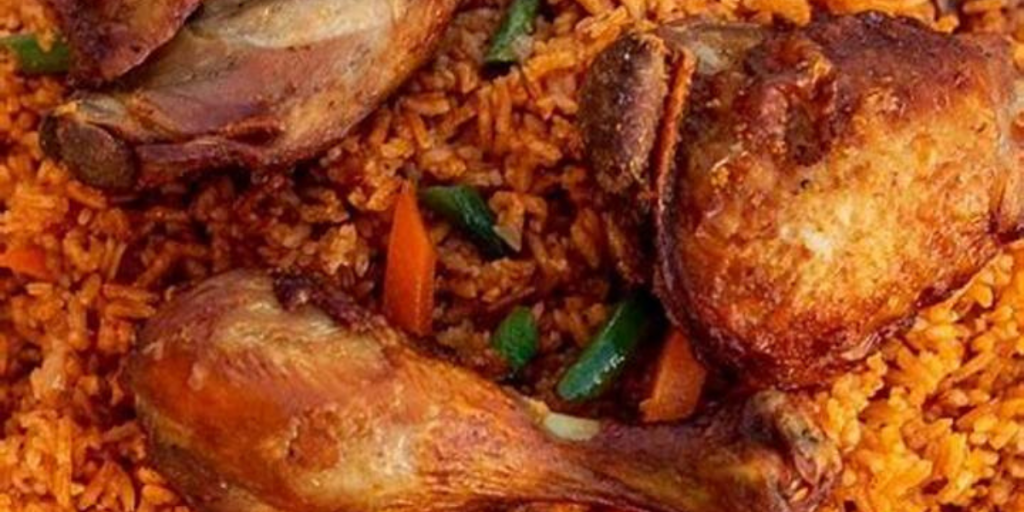
Nigerian dinner options reflect the country’s diverse culinary landscape, offering a range of flavors, textures, and ingredients that showcase the richness of Nigerian culture. From the fragrant spices of Fried Rice to the bold, tomatoey flavor of Jollof Rice, and from the starchy comfort of Amala to the hearty goodness of Egusi Soup, Nigerian dinner ideas are as varied as they are delicious. Ewa Agoyin, with its unique blend of mashed beans and spicy sauce, offers a taste of Lagos’s vibrant street food culture.
These meals are not just sustenance; they carry cultural and historical significance, connecting families and communities across the country. Whether you’re enjoying a plate of Fried Rice at a party, sharing a bowl of Egusi Soup with loved ones, or indulging in the simple pleasure of Ewa Agoyin from a street vendor, Nigerian dinner ideas provide a culinary journey that is as fulfilling as it is flavorful.
Each dish offers a unique blend of ingredients and techniques, passed down through generations, and continues to evolve with modern twists and variations. These Nigerian dinner ideas stand as a testament to the country’s rich food heritage, providing comfort, nourishment, and a sense of belonging to everyone who partakes in them.
















